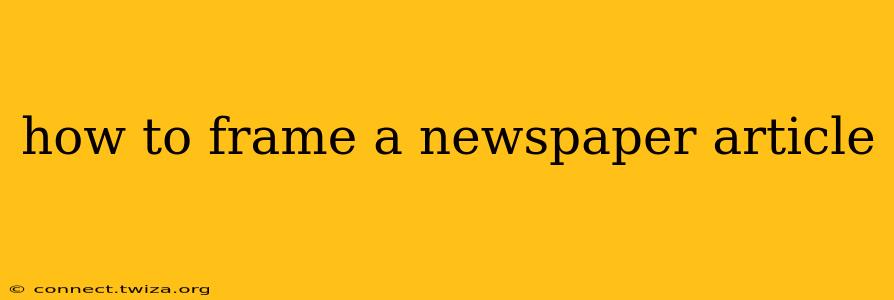How to Frame a Newspaper Article: A Guide to Structure, Style, and Impact
Crafting a compelling newspaper article involves more than just stringing together facts. It's about building a narrative that informs, engages, and resonates with readers. This guide will walk you through the essential elements of framing a newspaper article, from headline to conclusion.
What is the purpose of your article?
Before you even begin writing, you need a clear understanding of your article's purpose. Are you reporting on a breaking news event? Analyzing a complex issue? Profiling an interesting individual? The purpose dictates the angle, tone, and structure of your piece. Knowing your objective will help you focus your research and writing.
Choosing the right angle: The inverted pyramid
The inverted pyramid structure is a cornerstone of newspaper journalism. It prioritizes the most important information at the beginning of the article, gradually revealing less crucial details. This structure allows readers to quickly grasp the essence of the story even if they don't read the entire piece.
- Lead Paragraph (Lede): This is the most crucial part. It should concisely summarize the who, what, when, where, why, and how of the story. The lede needs to grab the reader's attention and compel them to read further. Consider starting with a strong quote, an intriguing fact, or a compelling anecdote.
- Supporting Paragraphs: These expand on the information presented in the lede, providing more context, details, and evidence. Each paragraph should focus on a single aspect of the story and maintain a logical flow.
- Background Information: As the article progresses, you can delve into background information, historical context, or related issues. This section provides deeper understanding for the reader.
- Quotes and Anecdotes: Incorporate direct quotes from sources to lend credibility and add a human element to the story. Anecdotes can help illustrate points and make the story more engaging.
- Conclusion: The conclusion should summarize the key findings or takeaways from the article and offer a sense of closure. Avoid introducing new information in the conclusion.
What are the key elements of a strong newspaper article?
- Accuracy: Fact-checking is paramount. Ensure all information is accurate and verifiable.
- Objectivity: While expressing opinions is fine in opinion pieces (op-eds), news articles should strive for objectivity, presenting all sides of a story fairly and without bias.
- Clarity: Write in clear, concise language that is easily understandable for the average reader. Avoid jargon or overly technical terms unless necessary and explained.
- Conciseness: Get to the point. Newspaper space is valuable; avoid unnecessary wordiness.
- Engagement: Use strong verbs, vivid descriptions, and engaging storytelling techniques to keep the reader interested.
How do I choose a headline and subheading?
The headline is the first thing a reader sees, so it needs to be compelling and accurately reflect the article's content. A strong headline should be concise, informative, and attention-grabbing. The subheading offers a brief elaboration on the headline, providing additional context and enticing the reader to delve deeper.
How do I structure a news report differently from a feature article?
News reports focus on factual accuracy and delivering information quickly and efficiently, usually adhering strictly to the inverted pyramid. Feature articles, on the other hand, allow for more creative storytelling and in-depth exploration of a topic. While they might employ elements of the inverted pyramid, they often prioritize narrative flow over strict adherence to the structure.
What are some common mistakes to avoid when writing a newspaper article?
- Plagiarism: Always cite your sources and avoid presenting others' work as your own.
- Bias: Strive for objectivity and fairness in presenting information.
- Poor grammar and spelling: Proofread carefully before submission.
- Lack of clarity: Ensure your writing is concise and easy to understand.
- Ignoring the inverted pyramid: Failing to prioritize important information can confuse the reader.
By mastering these techniques and avoiding common pitfalls, you can effectively frame your newspaper articles for maximum impact and reader engagement. Remember, good journalism is about informing and engaging your audience while adhering to the highest standards of accuracy and ethical conduct.
